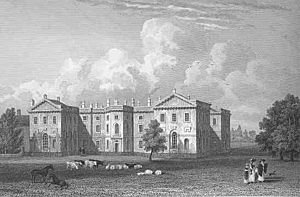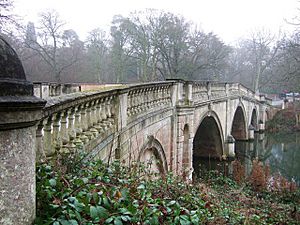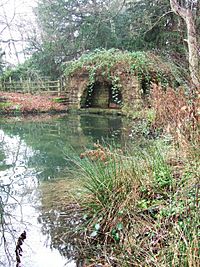Clumber Park facts for kids
Quick facts for kids Clumber Park |
|
|---|---|

The Lime Tree Avenue at Clumber Park, the longest of its kind in Europe. Planted in 1840, 2 miles long with 1,296 common limes (Tilia x europaea)
|
|
| Lua error in Module:Location_map at line 420: attempt to index field 'wikibase' (a nil value). | |
| Location | Worksop, Nottinghamshire, England |
| Nearest city | Nottingham |
| OS grid | SK625755 |
| Area | 1,537 hectares (3,800 acres) |
| Operated by | National Trust |
| Visitors | 666,997 (2019) |
| Open | Park: 7.00am to dusk. Other facilities have more restricted times. |
| Status | SSSI (for map see Map) |
| Other information | Postcode: S80 3AZ |
Clumber Park is a huge country park located near Worksop in Nottinghamshire, England. It's part of an area known as The Dukeries, which once had several large estates owned by dukes. The land used to belong to the Pelham-Clintons, who were Dukes of Newcastle. Today, the National Trust owns and cares for Clumber Park. They bought it in 1946.
The main house at Clumber Park was taken down in 1938 after several fires damaged it. However, a beautiful chapel, built in the Gothic Revival style, and a four-acre kitchen garden are still there. These areas, along with the rest of the park, are looked after by the National Trust. They are open for everyone to visit all year round.
Contents
Exploring Clumber Park's Past
Clumber Park has a long history! It was even mentioned in the Domesday Book, a famous survey from 1086. In the Middle Ages, it was owned by monks. Later, it became property of the Holles family.
In 1709, John Holles, who was the 1st Duke of Newcastle, turned Clumber into a special deer park. The main house, located near the River Poulter, was first used as a hunting lodge.
Later, around 1759, a new owner named Lord Lincoln decided to make Clumber his main home. He started building a grander house and improving the park. Many people worked on the project, including builders and architects. The house changed and grew over many years.
Fires and Changes at Clumber House
In March 1879, a big fire badly damaged Clumber House. Many valuable paintings were lost, though some were saved because they were on loan elsewhere. It was a sad time for the estate.
Even though the owner, Henry Pelham-Clinton, was still young, plans were made to rebuild the house. Work continued for several years, adding new rooms and improving the building. They even improved the sewage system to protect the lake!
Another fire happened in 1912, but it caused less damage. However, after the First World War and the Great Depression, it became very expensive to keep up such a large house. Like many other grand homes at the time, Clumber House was taken down in 1938 to avoid high taxes.
Charles Boot's company helped demolish the house. Some parts, like statues and fountains, were moved to his own home, but many other pieces were sold. What remains of the main house today is the Duke's study, which is now the Clumber Café.
The Bridge and Other Incidents
In 2018, the park's old ornamental bridge was badly damaged. It was built around the 1760s and is a very important historical structure. The bridge had to be closed.
Workers carefully recovered broken stone pieces from the river. Then, stonemasons began to rebuild the bridge, using some of the original stones. In July 2020, the bridge was reopened, but now only people walking can cross it. Cars are no longer allowed.
Around the same time, there were other incidents in the park, including damage to a barn and the theft of old plaques from a war memorial.
Discovering the Clumber Estate
Clumber Park is huge, covering over 3,800 acres! It includes thick woods, open heathland, and rolling farmland. One of its most famous features is the longest double avenue of lime trees in Europe. This amazing avenue was planted in the 1800s and stretches for more than two miles (4 km).
Clumber Lake
Clumber Lake is a large, winding lake that covers 87 acres. It's located south of where the main house used to be. The lake has been rebuilt a couple of times, partly because of ground sinking from coal mining nearby. A small place called Hardwick Village is also located within the park, near the eastern end of the lake.
Most of the land and buildings were sold in 1927 to pay off debts. Then, in 1946, the National Trust bought them. Now, parts of the park are open to the public, and you can drive your car into certain areas.
Things to Do at Clumber Park
Near the main parking area, you'll find a cricket pitch with a charming pavilion that looks like a thatched cottage. There are also large open spaces perfect for parking and having a picnic.
Clumber Park is a fantastic place for walkers, with miles of paths and cycle tracks around the lake. You can even hire bicycles there! The visitor centre is in the old stable block. It has a display about the park's history, a shop, and a restaurant. If you like camping, there are facilities near the main lime tree avenue.
Route 6 of the National Cycle Network goes right through the park. This connects Clumber Park to other cool places like Sherwood Forest and Sherwood Pines.
The Walled Kitchen Garden
East of the cricket pitch is a four-acre walled kitchen garden. It has a huge glasshouse that's 450 feet long! Inside, you can see plants like Pelargoniums, grapevines, and even a Butia capitata palm. This glasshouse used to have a special heating system under the floor, which allowed exotic plants to grow all year round using local coal.
The garden is divided by paths and grows all sorts of vegetables, herbs, fruits, and flowers. There's also a beautiful rose garden. The garden grows special local types of plants, like 'Clayworth Prize Pink' celery and over 101 kinds of apple from the Nottinghamshire area. They also have a huge collection of rhubarb, with more than 135 different types!
A special iron gate at the lower end of the garden helps cold air and moisture move out. This stops frost from forming, which could harm delicate plants.
A Special Place for Nature
In 1981, a large part of Clumber Park (over 1,300 acres) was named a SSSI. This means it's a very important place for nature. It has many different habitats, like the lake and wetlands, grasslands, heath, and old woodlands.
The old trees and decaying wood are perfect homes for many kinds of beetles. You can also find special birds breeding here, such as nightjars, woodlarks, redstarts, hawfinches, water rails, and gadwalls.
To help manage the grasslands and protect rare farm animals, old breeds of English Longhorn cattle and Jacob sheep have been brought to graze near the lake.
Events at Clumber Park
If you like running, a Parkrun event takes place in the park every Saturday morning!






